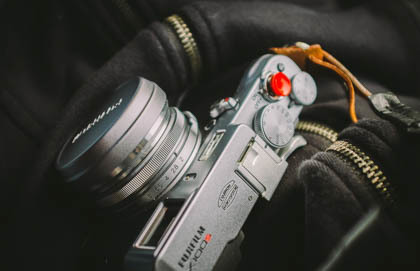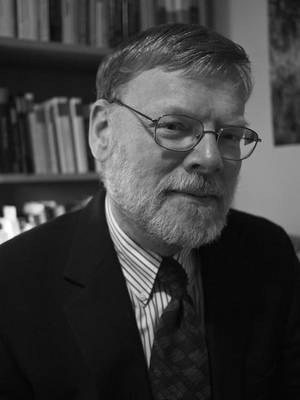Photography sounds easy. You see something you like, you click, and there you go. Yet most of the time, we end up photographing not what is in front of us but what is in our minds. We make reality fit our preconceptions: "This would make a great picture, it's just like a postcard!" We make photographs of photographs because we think this looks better. And then often we are disappointed because our pictures don't correspond to what we saw, and we are not sure why this is so. They don't seem to carry the same power to strike one, to make one stop and look. They are not as attractive as what pulled us over in the first place. It's harder to take a photograph of what is really before us, but in the end it is infinitely more interesting because it is always new.
About five years ago, I began a photographic project based on the churches of Lamont County in Alberta. My pictures of the churches were nice: the technique was fine, the colours were accurate, the composition was balanced, the framing was tight to avoid extraneous subject matter, and the churches stood out clearly. The buildings were tall and majestic. It was very suitable to a religious subject.
The images, however, were reminiscent of an old Sears catalogue rather than the living traces of a proud and important history. The images were boring. They did not reflect the wonder I had felt in their presence. More objectively, the images failed to portray mystery.
In truth, I only became aware of this failure as my project was already well advanced. As I was returning to some churches three or four times, as well as in different seasons, my pictures changed. I was moving farther away from the subject. I was giving the churches more land and more sky. The elements I had previously made efforts to avoid were increasingly important parts of the compositions. The tire tracks in the snow, which made a pair of inverted v's before the front door, were no longer annoying disturbances to the purity of a church in a winter landscape but signs of a human presence with the added symbolic value of pointing the way toward the entrance. The farming paraphernalia in the background or in the foreground was no longer an element to be censored by moving closer to the church but a sure sign of the people who used this house of prayer and worship. The electrical wires were no longer elements that broke the continuous plane of the sky but concrete proof that the people needed not only spiritual heat and light but also the physical variety.
The earlier images were driven by what a church ought to look like. The technique and the composition were dominated by a preconception according to which the traces of a human presence are a blemish on the spiritual church. The result was a picture of a disincarnate church deprived of human context. The later images portrayed the churches as incarnate in a human world, where the physical is no longer an impediment to the spiritual but its chosen means of communication.
Now someone may say that the later images were also the result of preconception, albeit a different one. The evidence, however, does not support this hypothesis. The later images came later because they came after more staring, after having learned from the reality before my eyes. When looking at a church, the desire is to know it, to understand the mystery it represents. The more complete pictures, the ones that included the elements of human presence, were in answer to my desire for a more complete understanding, just as they were an answer to the desire for knowledge, for the truth and for the beauty of the church. I cannot say that the later images represented the truth of the churches, but I can say that they were much closer to the truth, that they were created not by elimination but by inclusion. Yes, we are indeed taught that a successful composition needs to simplify and to eliminate all extraneous elements. But in this case, to eliminate elements of human presence would have been to approximate a lie in relation to the nature of the church.
The churches look quite different in winter. It is not simply a matter of the same church now surrounded by white snow. Somehow, winter opens new possibilities that do not equal the sum of its parts. There was one church that I had visited several times in the summer. A winding road descending to a small bridge before the church made it particularly attractive. Now, the emptiness and the barrenness caused by the blanket of snow and the cloudy sky made me aware of a dimension that I had so far ignored. I had been mesmerized by the picturesque quality provided by the winding road and the little bridge. I was taken in by the postcard quality and that very attractiveness prevented me from seeing further aspects that led to a deeper understanding of the church. I walked away from the road and the little bridge, moving around and a bit farther from the church. From my new vantage point, the horizon line was less noticeable and the church was thus situated in a white continuum between earth and sky. Other than the church itself, only a car offered a point of reference on this white canvas. Somehow, it was just right. I had just seen something new; and I am not sure I would be able to put it all into words, but I was grateful.
One winter morning, when it was -30, my friend and I drove to one of our favourite churches to see what it looked like in the magic light of dawn. This was a church in serious disrepair. The roof was leaking and the foundation was cracked in several places. It also badly needed a paint job. Yet, for some reason, this old and decrepit church dedicated to the Transfiguration of Our Lord had won our hearts. Perhaps it was the way it overlooked the neighbouring fields or the way it reflected a certain pride in the midst of its tenuous condition. That morning, it was glorious. True to its name, it shone as though from within, glowing with a beauty that demanded reverence. Wherever we stood, it was a feast for the eyes. We were spoiled and humbled. As the sun rose, the moment passed, but a lesson was learned: whatever the appearance may seem, there is more to the presence of the real. Sometimes it takes a freezing morning and the light of dawn to manifest itself.
It is true that we cannot eliminate preconceptions altogether, nor should we want to, as though the ideal of photography were the surveillance cameras or closed-circuit television. No, there is no visual equivalent to the tabula rasa in photographic seeing. The interplay of subject and object is more subtle, where the primacy always lies with the object, and where the subject's greatest and most intense activity is always marked by an element of passivity, where the object is acknowledged and received and where proper thanks for that object are given.
Now, isn't this all getting a bit heavy here? After all, we are talking about taking some pictures, right? And maybe improving a little? Well, no. It's about more than that, much more. What is at stake for me is knowledge of reality. Photography represents a privileged medium of interacting with the world around me, allowing me to be provoked by its attraction, and befriending its reality. When I struggle with point of view, composition, depth of field and exposure, it is a way for me to pay attention to the world, to the real that surrounds me and provokes me. It is a way to take that provocation seriously and to understand it. My photographs are ways of responding to the real. They are also part of a larger chain of communication, allowing others to be provoked by the attraction of the world. They are a bit like a report card on my ability to listen to the real, except that the "success" is measured by the ability of the picture to show more of reality and to invite greater exploration of the real. In this way, photography is always incomplete.
The churches project taught me not to be satisfied with boring pictures. It taught me to take seriously my desire for greater knowledge of the reality in front of me. It taught me not to settle for what I already know but to seek out the new. It taught me to prefer, as the Catholic theologian Father Luigi Giussani has said, truth to my own image of it.
I used the telephoto much less. I picked up the wide angle much more readily. As I moved away from the church to include more of its context and environment, I also moved further from my own preconceptions. And I came closer to the reality of the church before me.



